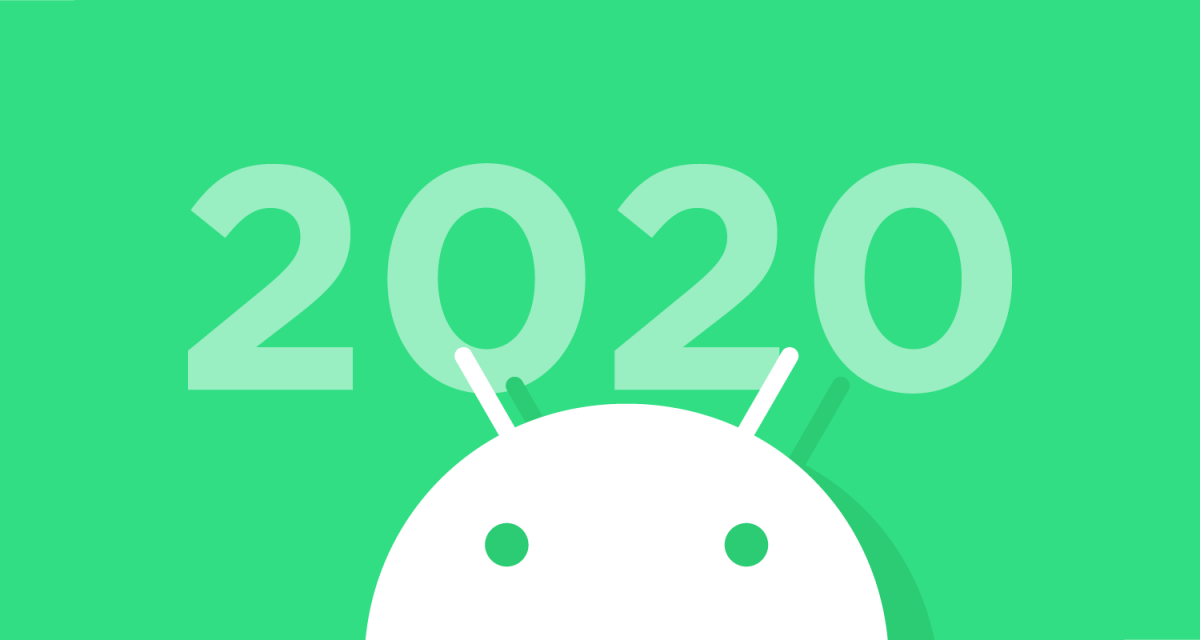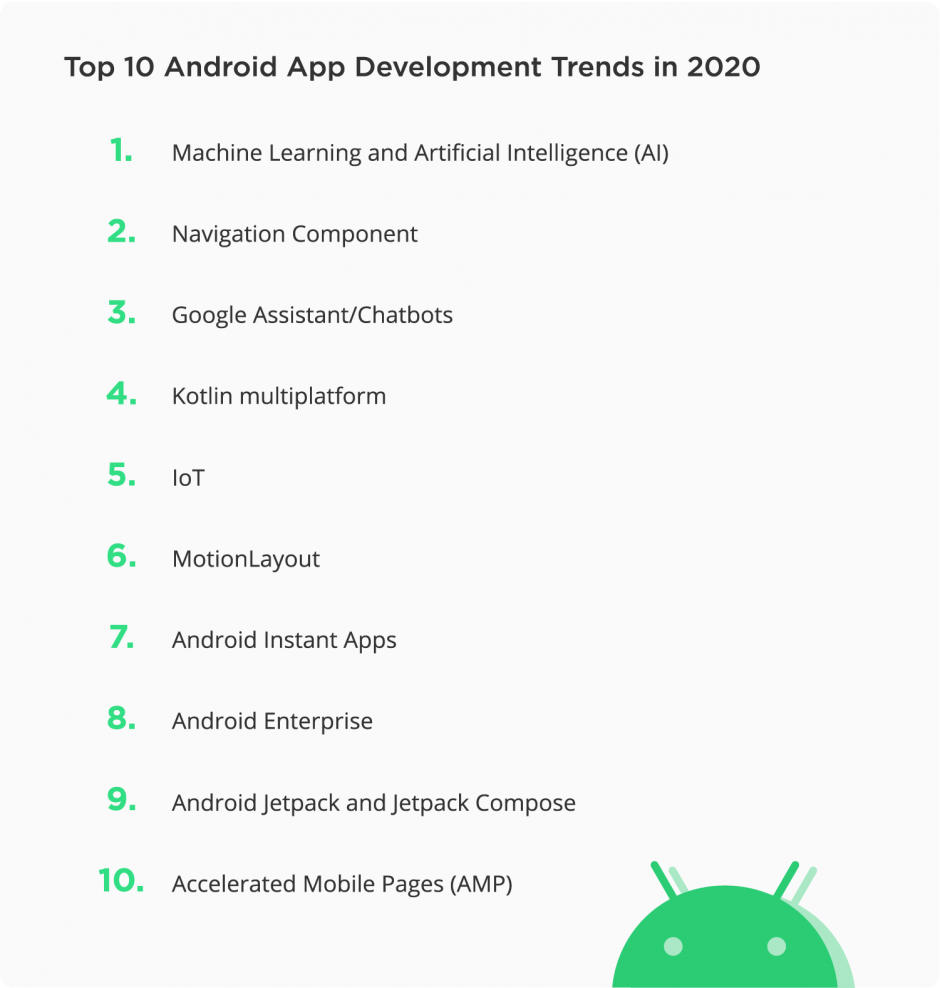Top 10 Android App Development Trends | Guide
Discover the key trends in Android development that are going to explode in 2020 and build a modern mobile application.

Are you a business owner looking to build a mobile app this year? Then you need all the insights you can get about the key trends in mobile app development. We’ve previously covered the most important iOS trends for 2020, and top mobile app design trends that will rule in 2020. Now it’s time to take a look at Android mobile app development trends for 2020.
If you’re planning to create a digital product for the Android platform, we’ve got you covered. Read on to discover the ten most important trends in Android development that are going to explode this year.
Skip to a section:
- Machine Learning and Artificial Intelligence (AI)
- Navigation Component
- Google Assistant/Chatbots
- Kotlin multiplatform
- IoT
- MotionLayout
- Android Instant Apps
- Android Enterprise
- Android Jetpack and Jetpack Compose
- Accelerated Mobile Pages (AMP)
1. Machine Learning and Artificial Intelligence (AI)
Artificial Intelligence (AI) – and its subset Machine learning (ML) – refers to a set of programming techniques that allow apps to automatically learn and improve from experience without being programmed to do so explicitly.
This approach comes in handy for apps that use unstructured data (such as images and text) or solve problems that include a large number of parameters. For example, apps that predict what customers would like to see or buy next. Luckily, Android supports a wide range of ML tools and methods, so implementing this type of cutting-edge functionality is easier than you may expect.
When developing an ML app for Android, the development team needs to design a product, implement inference algorithms, and deploy the existing ML models, retrain them, or build new ones. Google prepared two guides to help businesses succeed in building AI-powered apps: the People + AI Guidebook and The Material Design for Machine Learning spec, which includes design guidelines and patterns for ML-powered features like object detection or barcode scanning.
Android developers can find pre-trained models in ML Kit and Google Cloud, or build a brand-new model using TensorFlow. An important decision here is dividing whether inferencing in your solution runs on the device or uses a remote cloud service.
2. Navigation Component
Navigation refers to all of the interactions that allow moving around different sections and pieces of content within your app. Android Jetpack comes with a handy Navigation component that helps developers to implement navigation, whether it’s a simple button click or a more complex pattern like a navigation drawer.
Another advantage of the Navigation component is that it also ensures a consistent and predictable user experience since developers who implement it will follow established navigation principles.
The Navigation component consists of three parts:
- Navigation graph – an XML resource that includes all of the navigation-related information in a single location (like individual content areas called destinations and possible paths users can take through the app).
- NavHost – an empty container that shows all the destinations in your navigation graph.
- NavController – an object that manages the app navigation within a NavHost.
The Navigation component also allows developers to handle fragment transactions, manage the Up and Back actions correctly by default, and implement deep linking. It also provides standardized resources for animations and transitions, as well as navigation UI patterns.
3. Google Assistant/Chatbots
In 2020, more business owners will be interested in integrating the content and services of their apps with the Google Assistant. The main perk of investing in this type of integration is that you can provide faster ways for users to access your app directly in the Assistant.
By using App Actions, you can deep-link to specific activities inside your mobile application from the Google Assistant. Another feature, Android Slices, allows developers to display the most important content from your app to the users to the Assistant. With the numbers of Google Assistant users on the rise, integrating mobile apps with this popular virtual assistant will become a key goal among many development teams.
Read also about 7 ideas for growing your business with Google Assistant.
4. Kotlin multiplatform
Kotlin now offers developers a new exciting feature: multiplatform projects (which can serve as a replacement for Flutter). It’s still an experimental feature available in Kotlin 1.2 and 1.3, but we think it’s going to become really big in 2020.
Sharing code between platforms is something Kotlin aspires to. It supports systems and technologies such as Android, iOS, JVM, JavaScript, Linux, Windows, Mac, and embedded systems such as STM32. Development teams can easily share their code between these platforms. That way, it accelerates the development process and saves lots of time the team can dedicate to more challenging tasks.
By using multiplatform, developers can build components that share as much code as required with others. They can also access the platform APIs anytime. For example, by using this feature, you can build a mobile application with parts of the code (like business logic or connectivity) shared between Android and iOS. You can also share code between the client and server which comes in handy when building apps the use APIs.
Code reuse is a serious benefit. That’s why we’re going to see more and more teams taking advantage of Kotlin for mobile app development.
5. IoT
Implementations of the Internet of Things (IoT) in Android app development is another key trend.
In the Android world, this trend translates into Android Things, which allows developers to build devices on top of popular hardware platforms like Raspberry Pi.
Developers don’t need any knowledge of embedded system design to get started. Instead, they can develop apps using the Android SDK and Android Studio. The framework allows easy native access to hardware, such as cameras and displays. You can also connect your app to Google services and integrate extra peripherals with the Peripheral I/O APIs. The Android Things Console also helps teams to push new features and security updates over-the-air.
Once your app is ready, you can start publishing your code to devices with the help of the Android Things Console. It offers tools for installing and updating the system image on supported hardware devices.
6. MotionLayout
MotionLayout is a type of layout that developers can use to manage motion and widget animation in their apps. The tool is part of the ConstraintLayout library and is backward-compatible with Android 4.0.
With the library, the team can easily fill the gap between layout transitions and complex motion handling as the tool offers a rich selection of features. MotionLayout not only describes transitions between layouts but also allows animating any layout properties. It also supports seekable transitions, enabling developers to instantly show any point within the transition on the basis of a condition like a touch input.
Note that MotionLayout will only work with its direct children and won’t support nested layout hierarchies or activity transitions.
In 2020, developers will be using MotionLayout to create interfaces that use animation to help users understand what is happening in the app and have a better experience.
7. Android Instant Apps
In 2020, we’re also going to witness the rise of Android Instant Apps. What are instant apps? Instant apps are apps that don’t require installation to be used by app users. Google Play Instant allows native apps and games to launch on devices without being installed (they need to run on Android 5.0 or newer).
Developers can build instant apps and instant games using Android Studio. By providing an instant experience to app users, you can boost your app or game’s discovery, increase the number of installations, and acquire more active users.
At the moment, Google Play Instant offers two levels of instant experiences: basic and enhanced. The basic instant experience lets users tap on a Try Now button or website banner to get access to an instant experience. The enhanced instant experience allows users to launch an instant experience from any surface able to launch a URL.
8. Android Enterprise
Digital transformation is a critical trend for enterprises in 2020. This Google-led initiative aims to enable workers to use Android devices and apps in the workplace. The Android Enterprise program provides developers with APIs and other tools to integrate support for Android into their enterprise mobility management (EMM) solutions.
The most common enterprise deployment scenarios for Android devices are:
- employee-owned devices (BYOD),
- company-owned devices for knowledge workers,
- and company-owned devices for dedicated use (both employee and customer-facing, like hospital check-in stations or inventory management devices).
They all present different challenges to development teams, but we’re surely going to see them become more prominent in the Android development field.
9. Android Jetpack and Jetpack Compose
This suite of libraries and tools helps Android developers to write high-quality code faster, follow best practices, and simplify complex tasks. In 2020, Android Jetpack will become even more relevant to mobile development projects because it’s constantly expanded with new tools.
One of the tools that are going to become big in 2020 is Jetpack Compose, Android’s toolkit for building native UI. The solution accelerates the process of building user interfaces on Android. Developers can create their app with less code by avoiding entire classes of bugs. That simplifies the code and makes it easy to maintain.
All you need to do is describe the UI and Compose will take care of everything. When the app state changes, the UI will be updated automatically. Compose is compatible with all your existing code, so it’s possible to adopt it easily.
Note: At the time of writing this article, Jetpack Compose in Developer Preview. The API surface isn’t complete yet, and you can expect some changes to be added to it.
10. Accelerated Mobile Pages (AMP)
The emergence of instant apps has changed the mobile landscape, and the trend is likely to continue in 2020. However, web pages displayed on mobile devices have become more enjoyable and intuitive than ever. That’s why it shouldn’t come as a surprise that this year we will also witness more interest in Google’s Accelerated Mobile Pages (AMP) initiative.
What is AMP? It’s a brand-new technology that offers a smart method for publishers to improve their visibility in mobile search. Accelerated Mobile Pages enhance search engine optimization (SEO) and help companies to be more discoverable by users. Google’s search algorithms are constantly evolving, and to meet the changing demands it’s best to follow Google’s own recommendations.
Right now, Google is all about mobile. Did you know that more people perform searches on mobile devices than desktop devices? Speed and performance are two key factors that influence a site’s rank. And they’re precisely what Google is encouraging with Accelerated Mobile Pages. According to Google, AMP sites load 4x faster than average non-AMP sites. Users get to access their content in just 1 second.
The mobile scene is highly competitive, and companies are doing everything they can to gain visibility. Google is going to give more prominence to AMP in search engine results pages, driving lots of traffic to your site.
That’s all when it comes to Android development 2020 trends, read also about common mistakes that can ruin your mobile app development.
Conclusion
These ten technology trends are just the tip of the iceberg in the constantly evolving mobile scene. We hope that this article helps you to make the best technology choices for your mobile development project in 2020 and beyond. 
Are you looking for an Android development team that can build a modern solution?
Get in touch with us. For 9 years we specialize in building mobile apps – we delivered more than 130 projects for companies operating in various industries.
About the author
Start working on your Android app right away!
Receive your first working demo within 7 days from the project kick-off





#10 and #5 truly caught my attention